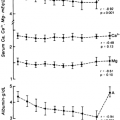USE OF CONTRACEPTIVE METHODS
Part of “CHAPTER 104 – FEMALE CONTRACEPTION“
A worldwide revolution occurred in the early 1960s with the introduction of oral and intrauterine contraception. Use of these methods accounts for up to one-third of the subsequent decline in birth rate.
Fertility rates are a measure of timing and numbers of births as well as the population’s preference for family size and acceptance of contraception. The U.S. fertility rate was at its peak (127 per 1000) in 1910, descended during the economic depression (89 per 1000 women), and then began an upward trend after World War II. By 1960, the rate was almost as high as it had been 50 years earlier (118 per 1000 women). The 1960s witnessed not only the introduction of modern contraceptive technologies but also a marked expansion in women’s economic and social opportunities, resulting in preferences for childbearing at older ages and for smaller families. These societal changes, along with scientific advances, made possible the development of new methods of birth control.
As of 1995, ˜39 million U.S. women 15 to 44 years of age (64%) were using some method of contraception. This total is
up from ˜30 million users (56%) in 1982. Of the 36% not using contraception, 5% were at risk of unintended pregnancy (the remainder were either pregnant, trying to get pregnant, sterile for noncontraceptive reasons, or not sexually active).1
up from ˜30 million users (56%) in 1982. Of the 36% not using contraception, 5% were at risk of unintended pregnancy (the remainder were either pregnant, trying to get pregnant, sterile for noncontraceptive reasons, or not sexually active).1
Stay updated, free articles. Join our Telegram channel

Full access? Get Clinical Tree






